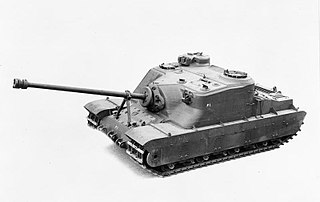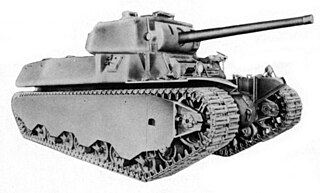
The Infantry Tank Mark II, better known as the Matilda, is a British infantry tank of the Second World War.

The Tank, Infantry, Mk IV (A22) Churchill was a British infantry tank used in the Second World War, best known for its heavy armour, large longitudinal chassis with all-around tracks with multiple bogies, its ability to climb steep slopes, and its use as the basis of many specialist vehicles. It was one of the heaviest Allied tanks of the war.

The Tank, Infantry, Mk III, Valentine was an infantry tank produced in the United Kingdom during World War II. More than 8,000 Valentines were produced in eleven marks, plus specialised variants, accounting for about a quarter of wartime British tank production. The variants included riveted and welded construction, petrol and diesel engines and increases in armament. It was supplied in large numbers to the USSR and built under licence in Canada. It was used by the British in the North African campaign. Developed by Vickers, it proved to be strong and reliable.

The Cromwell tank, officially Tank, Cruiser, Mk VIII, Cromwell (A27M), was one of the series of cruiser tanks fielded by Britain in the Second World War. Named after the English Civil War–era military leader Oliver Cromwell, the Cromwell was the first tank put into service by the British to combine high speed from a powerful, reliable engine and reasonable armour. The intended dual-purpose high-velocity gun could not be fitted in the turret, so a medium-velocity dual-purpose gun was fitted instead. Further development of the Cromwell combined with a high-velocity gun led to the Comet tank.

Crusader, in full "Tank, Cruiser Mk VI, Crusader", also known by its General Staff number A.15, was one of the primary British cruiser tanks during the early part of the Second World War. Over 5,000 tanks were manufactured and they made important contributions to the British victories during the North African campaign. The Crusader only saw active service in Africa but the chassis of the tank was modified to create anti-aircraft, fire support, observation, communication, bulldozer and recovery vehicle variants.

The Tank, Cruiser, Mk I (A9) was a British cruiser tank of the interwar period. It was the first cruiser tank: a fast tank designed to bypass the main enemy lines and engage the enemy's lines of communication, as well as enemy tanks. The Cruiser Mk II was a more heavily armoured adaptation of the Mark I, developed at much the same time.

The Tank, Cruiser, Mk II (A10), was a cruiser tank developed alongside the A9 cruiser tank, and was intended to be a heavier, infantry tank version of that type. In practice, it was not deemed suitable for the infantry tank role and was classified as a "heavy cruiser". It served briefly in World War II.

The Tank, Cruiser, Challenger (A30) was a British tank of World War II. It mounted the QF 17-pounder anti-tank gun on a chassis derived from the Cromwell tank to add anti-tank firepower to the cruiser tank units. The design compromises made in fitting the large gun onto the Cromwell chassis resulted in a tank with a powerful weapon and reduced armour. However, the extemporised 17-pounder Sherman Firefly conversion of the US-supplied Sherman proved easier to produce and, with delays in production, only 200 Challengers were built. The Challenger was able to keep up with the fast Cromwell tank and was used with them.

The Ordnance Quick-Firing 17-pounder was a 76.2 mm (3 inch) gun developed by the United Kingdom during World War II. It was used as an anti-tank gun on its own carriage, as well as equipping a number of British tanks. Used with the APDS shot, it was capable of defeating all but the thickest armour on German tanks. It was used to "up-gun" some foreign-built vehicles in British service, notably to produce the Sherman Firefly variant of the US M4 Sherman tank, giving British tank units the ability to hold their own against their German counterparts. In the anti-tank role, it was replaced after the war by the 120 mm BAT recoilless rifle. As a tank gun, it was succeeded by the 84 mm 20 pounder.

The infantry tank was a tank concept developed by the United Kingdom and France in the years leading up to World War II. Infantry tanks were designed to support infantrymen in an attack. To achieve this, the vehicles were generally heavily armoured to allow them to operate in close concert with infantry even under heavy fire. The extra armour came at the expense of speed, which was not an issue when supporting relatively slow-moving foot soldiers.

The Tortoise heavy assault tank (A39) was a British heavy assault gun design developed during the Second World War, but never put into mass production. It was developed for the task of clearing heavily fortified areas such as the Siegfried Line and as a result favoured armour protection over mobility.

Tank, Infantry, Black Prince (A43) is the name that was assigned to an experimental development of the Churchill tank with a larger, wider hull and a QF 17-pounder gun. It was named after Edward, the Black Prince, son of Edward III and heir to the English throne.

The Tank, Heavy, TOG 1 was a prototype British super-heavy tank produced in the early part of the Second World War in the expectation that battlefields might end up like those of the First World War. It was designed so it could cross churned-up countryside and trenches. A single prototype was built, and followed by an improved model, but interest faded with the successful performance of another cross-country design, the Churchill tank, and the mobile war that was being fought.

The Tank, Heavy Assault, A33 (Excelsior) was a British experimental heavy tank based on the Cromwell (A27) design developed in the Second World War. It was developed when there were concerns as to performance of the Churchill tank.

The Heavy Tank M6 was an American heavy tank designed during World War II. The tank was produced in small numbers and never saw combat.

The assault tank T14 was a joint project between the United States and the United Kingdom with the goal being to produce a universal infantry tank.

The Medium Mark III was a medium tank developed by the United Kingdom during the Interwar period.

This article on military tanks deals with the history and development of tanks of the British Army from their first use in the First World War, the interwar period, during the Second World War, the Cold War and modern era.
The Vickers Main Battle Tank Mk. 4 later known as the Vickers Valiant was a main battle tank developed as a private venture by British company Vickers for export. Its development began in 1976 and ended in January 1984. Although the Valiant did not enter production, its development provided valuable experience in the production of an aluminium-hulled, Chobham-armoured tank in the 40 tonnes weight range. A further development of its turret was later used for the Vickers Mk. 7 MBT.


















